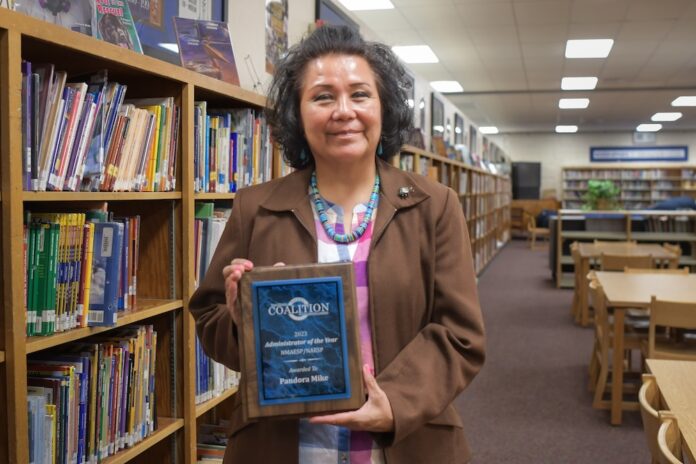Principal Pandora Mike identifies herself using her Navajo traditional clanship, and these cultural connections are an important way she connects with her students and staff.
At the beginning of each year, Mike, who was recently named a National Distinguished Principal by the National Association of Elementary School Principals, introduces herself in the Navajo language at an annual assembly where she shares her plans and goals for Tsé Bit’ A’í Middle School in Shiprock, New Mexico.
She asks students (nearly all of whom identify as Native American) and staff if they are also members of her family clans, the first of which is the: Naakai Diné nili, or “Mexican People clan.” “Those who raise their hands, I let them know ‘I am your grandmother,'” Mike explains.”‘From here on,’ I say, ‘if you see me in the hallway, you can call me Grandma.”
Mike also asks who belongs to her Hooghanlani yashchiin (Many Hogans People clan), Todichi’iinii da bi cheii (Bitter Water People), and Ta’neesdzahnii da bi nali (Tangle People clan). To some of these students, she is an aunt but to others can consider her a granddaughter. “That really tickles them—I tell them that means they’re going to have to take of me, and they like that,” Mike adds. “And I tell my non-Navajo teachers, ‘You’re now my adopted child, you’re clan when you identify yourself.'”
These connections build a strong sense of community and belonging, both of which create strong bonds for learning, adds Mike, whose building is part of the Central Consolidated School District in northwest New Mexico and the Navajo Nation. “We talk about fractions connected to building hogans and corrals,” says Mike, who is in her 18th year as a principal and third at her current school. “We also have teachers incorporating a time during class to do ‘Good News,’ giving everybody an opportunity to share something good that’s going on.”
A four-way philosophy
Restorative practices and a focus on social-emotional learning are two other ways Mike is building community at Tsé Bit’ A’í Middle School. Mike has incorporated Navajo—or Diné—philosophies into her approach. That means looking to the four directions of the compass:
- East: Sets direction to learn about one’s identity and core values;
- South: Developing strategies and skills to be life-ready physically, mentally, emotionally and socially;
- West: Learning the value of and establishing strong relationships with family, friends and clan systems;
- North: Looking at how one has come to where they are by reflecting on our past, looking to our future and knowing our inner-relatedness with our environment.
More from DA: 3 Principal of the Year finalists described as transformational educators
“It really focuses on empowering students and understanding responsibility,” says Mike, who has also served as the chair of New Mexico’s Indian Education Advisory Council. “It’s about the wellness of the staff, it’s about the wellness of the students, it’s about the wellness of the school as a whole.”
To that end, students and teachers collaborate on social contracts that lay out norms for each classroom. Tsé Bit’ A’í Middle School also has a supervised calming room, known as the “Blue Room,” where students can go if they are feeling anxious or upset. Mike and her team also constantly monitor data to identify students who need extra support or whose parents need to be contacted for further assistance.
“Most of the time,” she asserts, “it’s really a listening ear. We have to be good listeners to watch for those key factors that students and parents are telling us, so we can find the right supports for them.”
Students also have access to classes in the Diné language and Navajo heritage, and a Pow-Wow Club. “You can count on weekly drumming when walk into the school in the morning. That’s very soothing,” she concludes.










